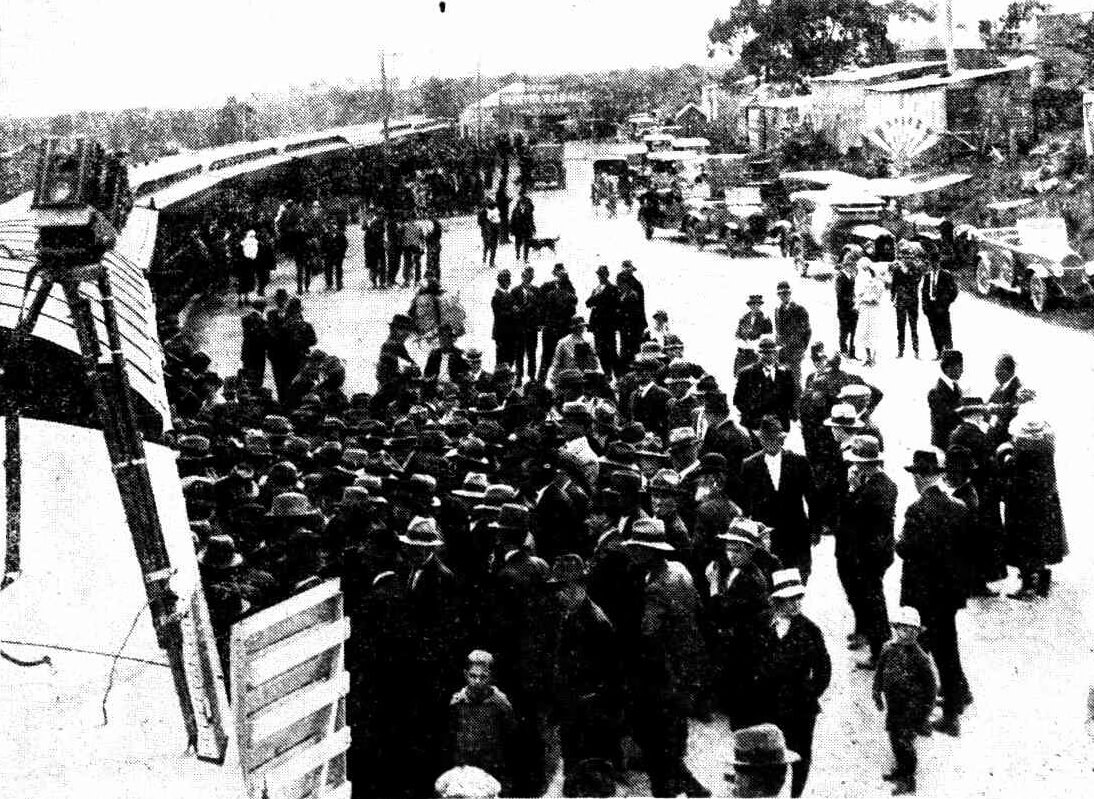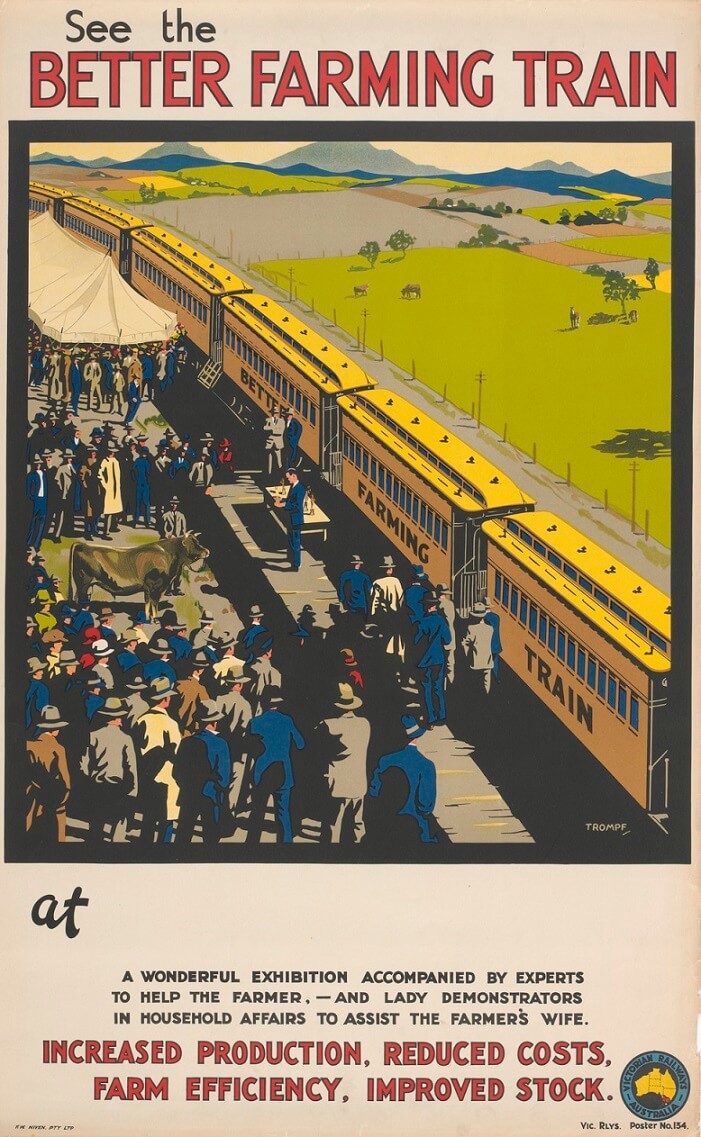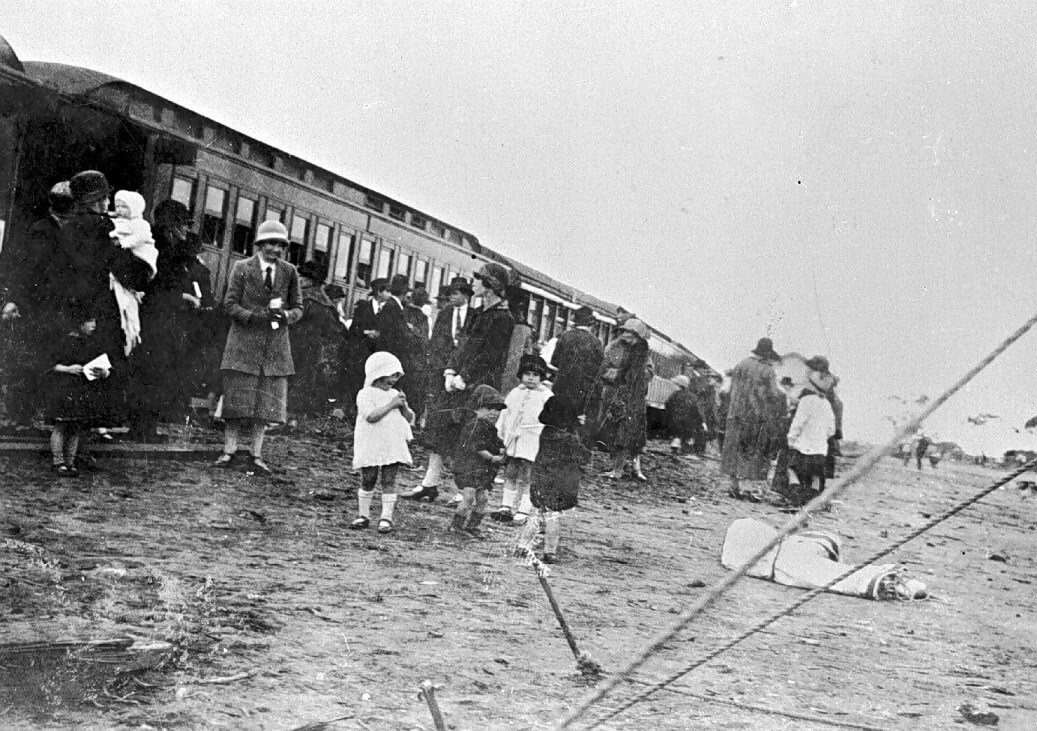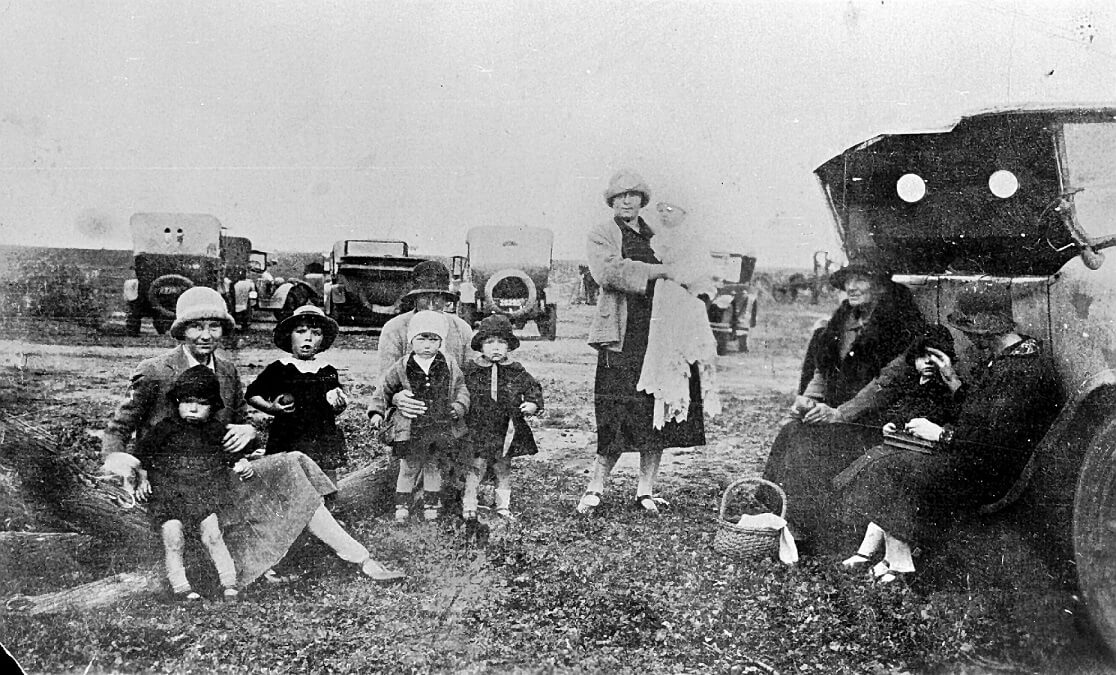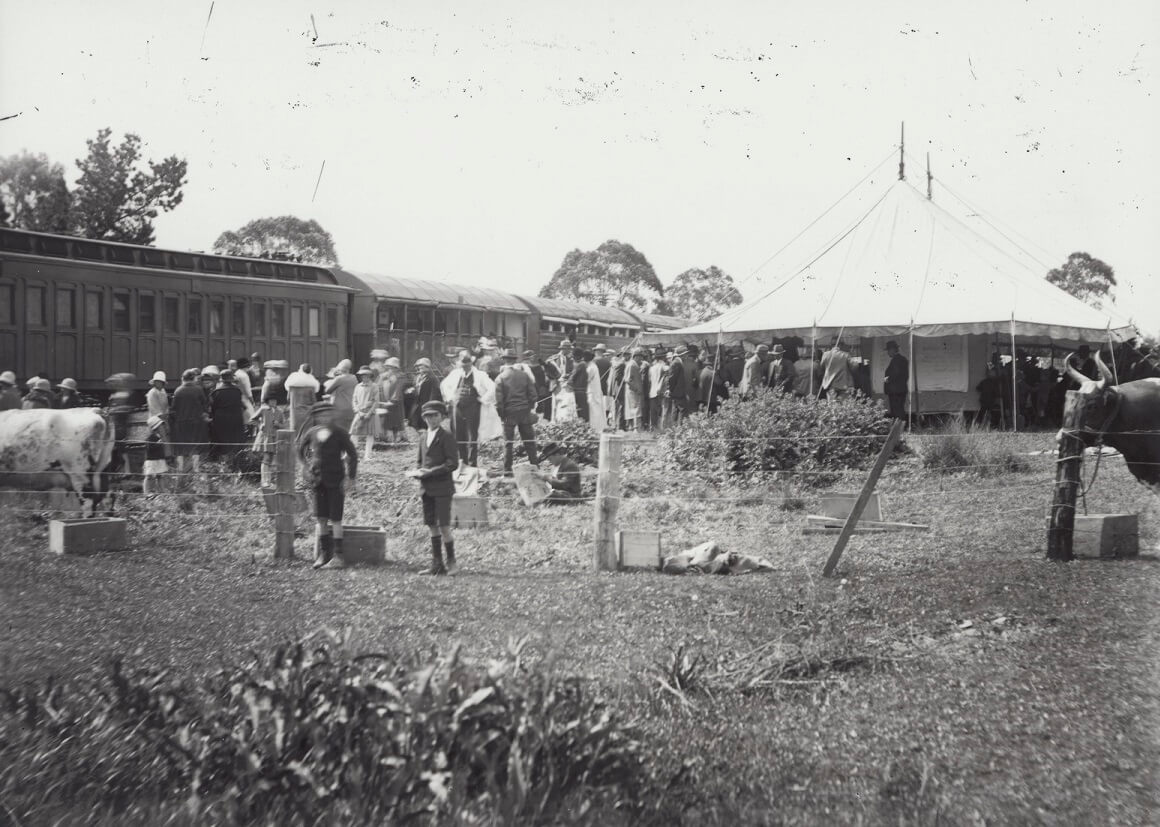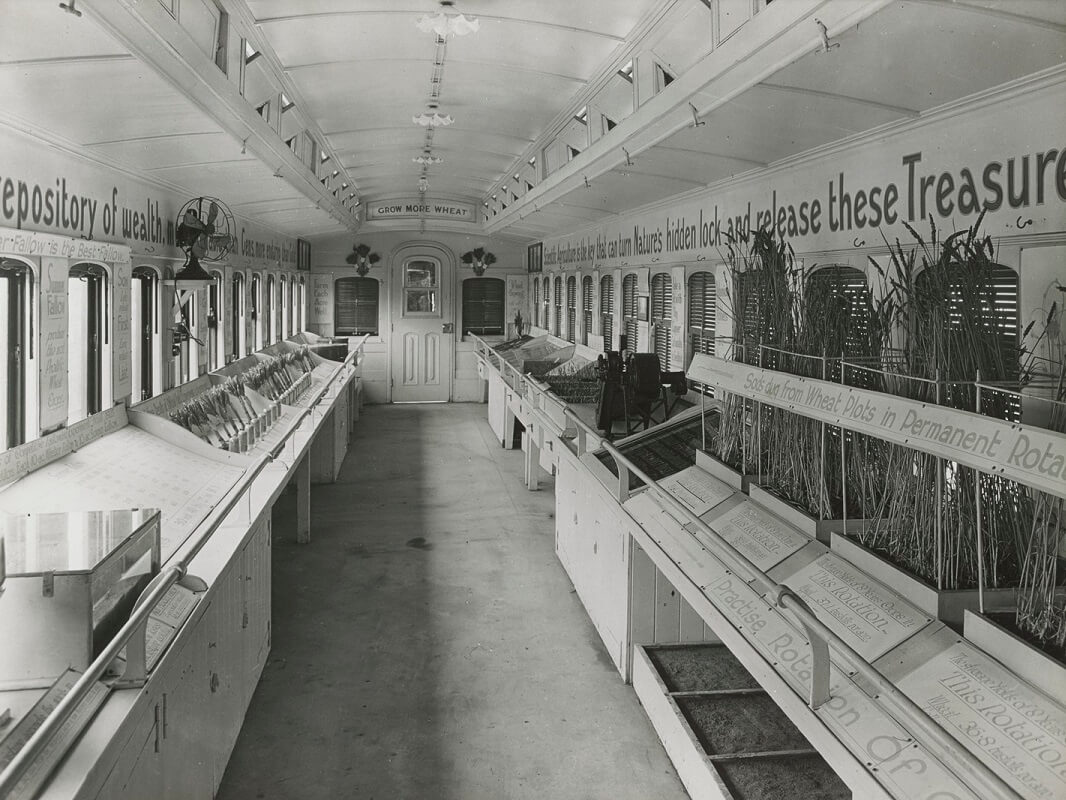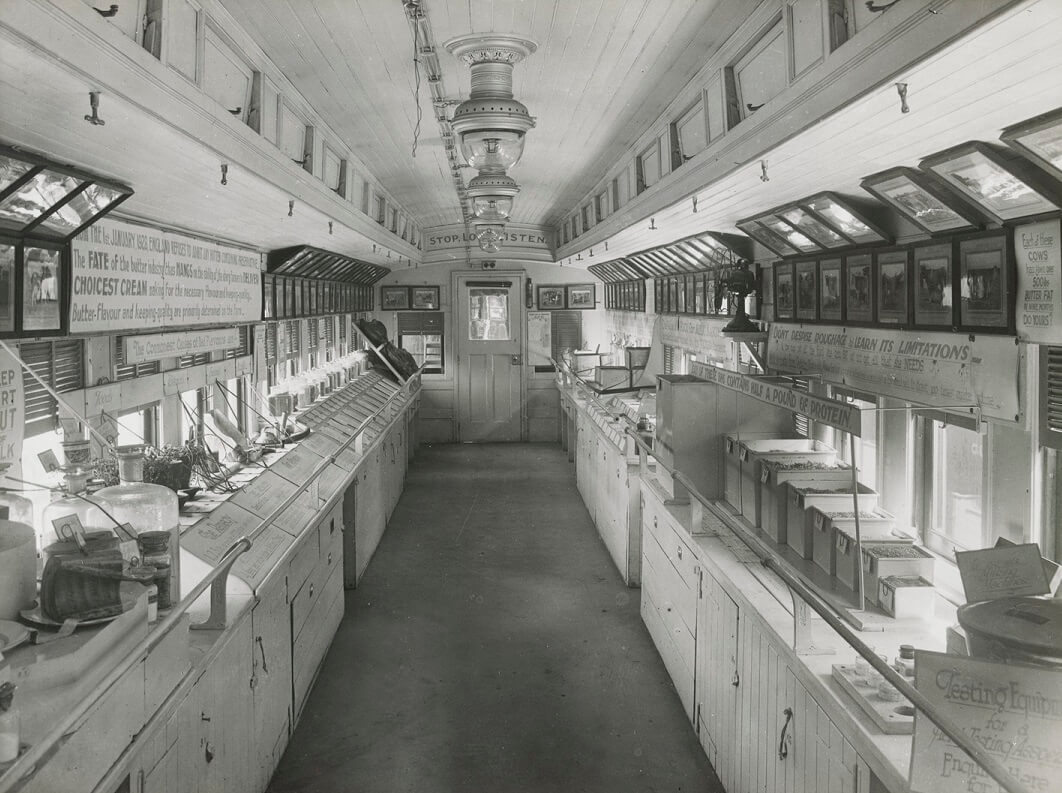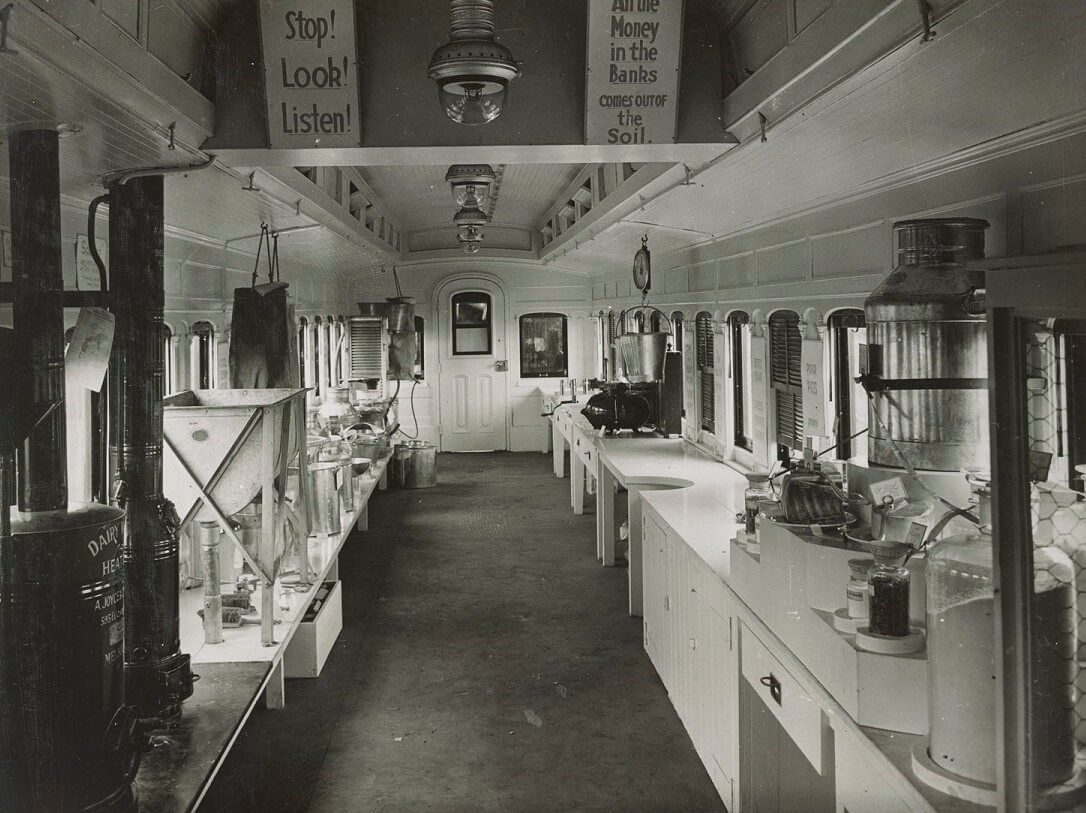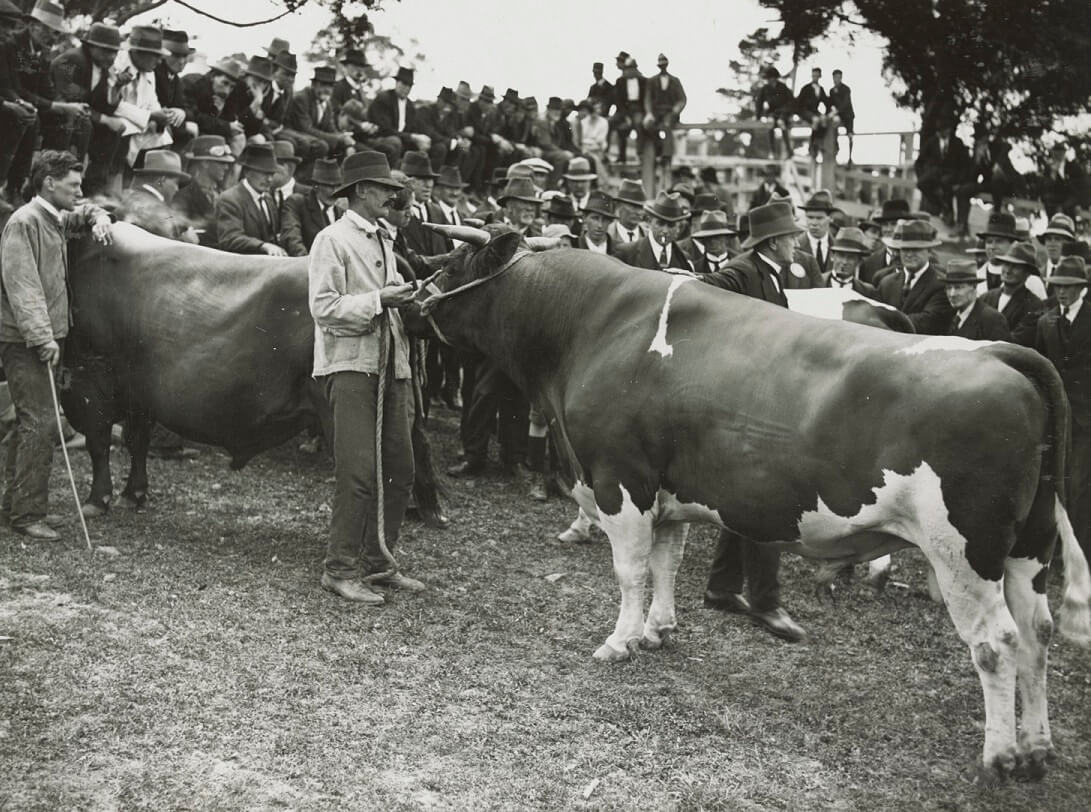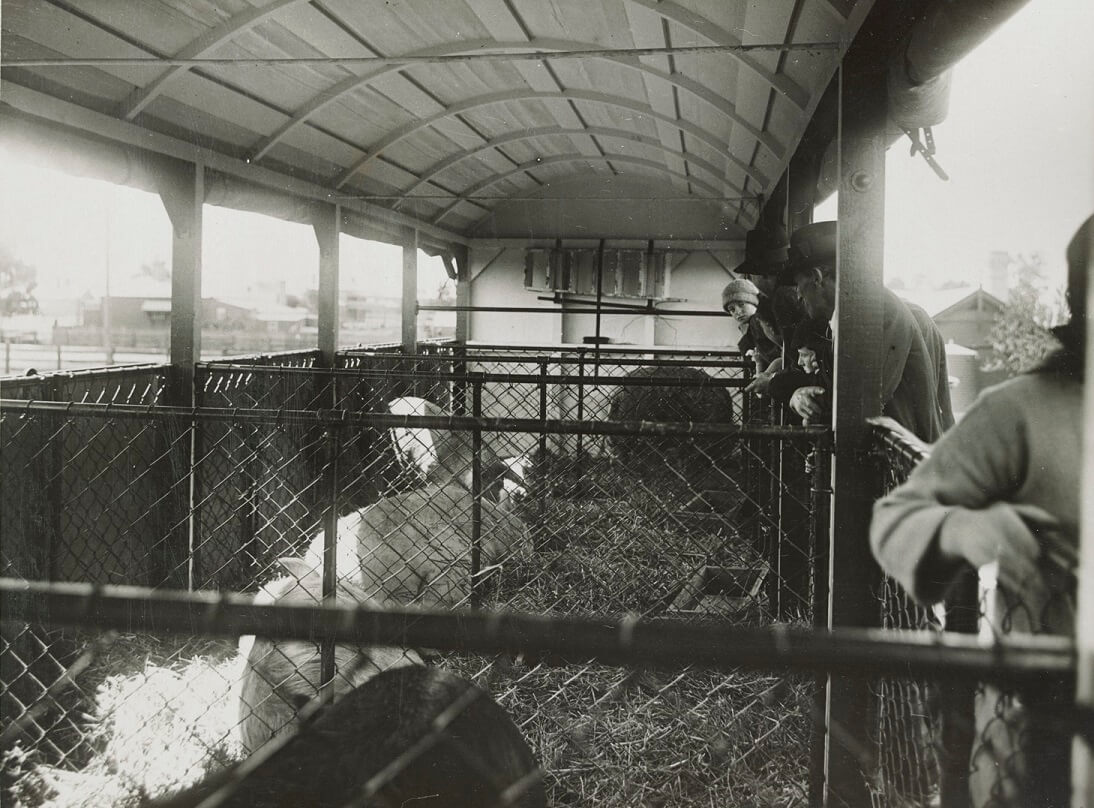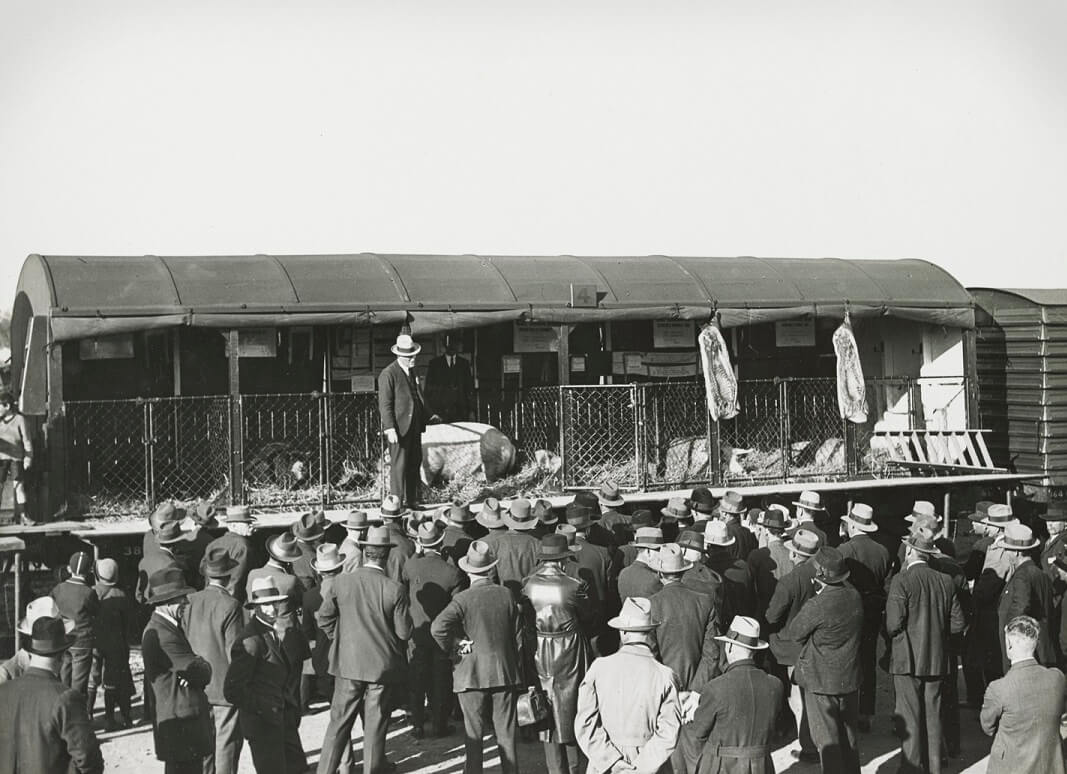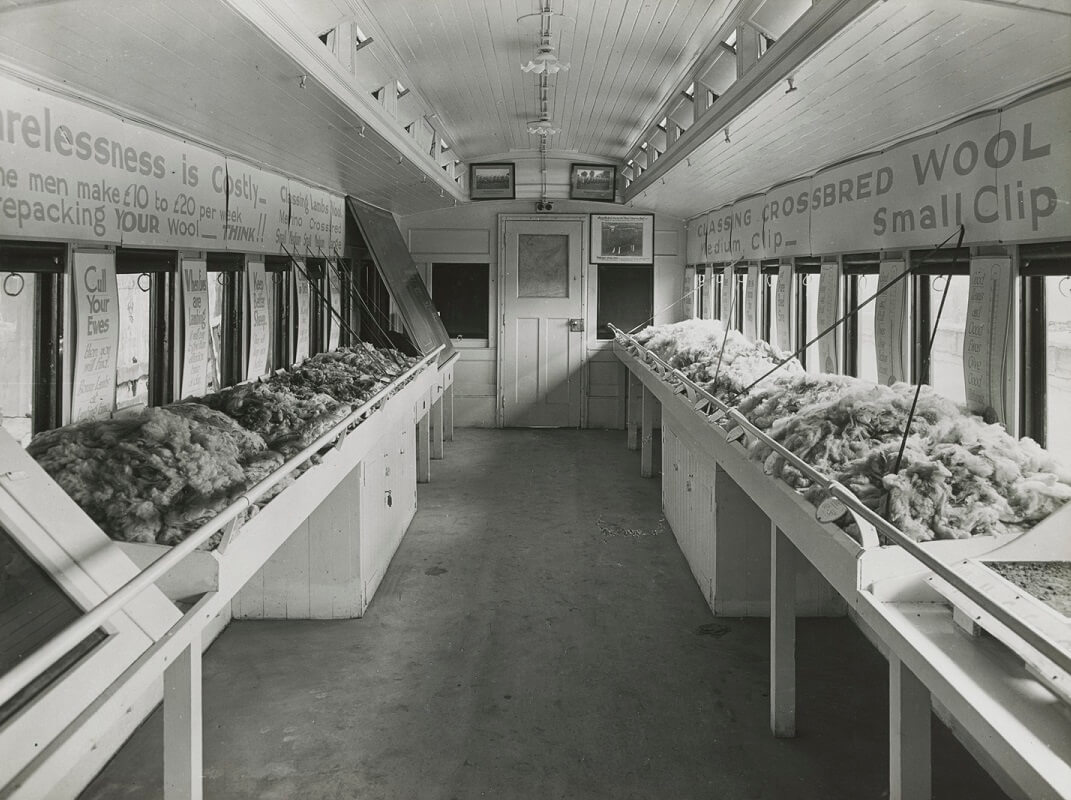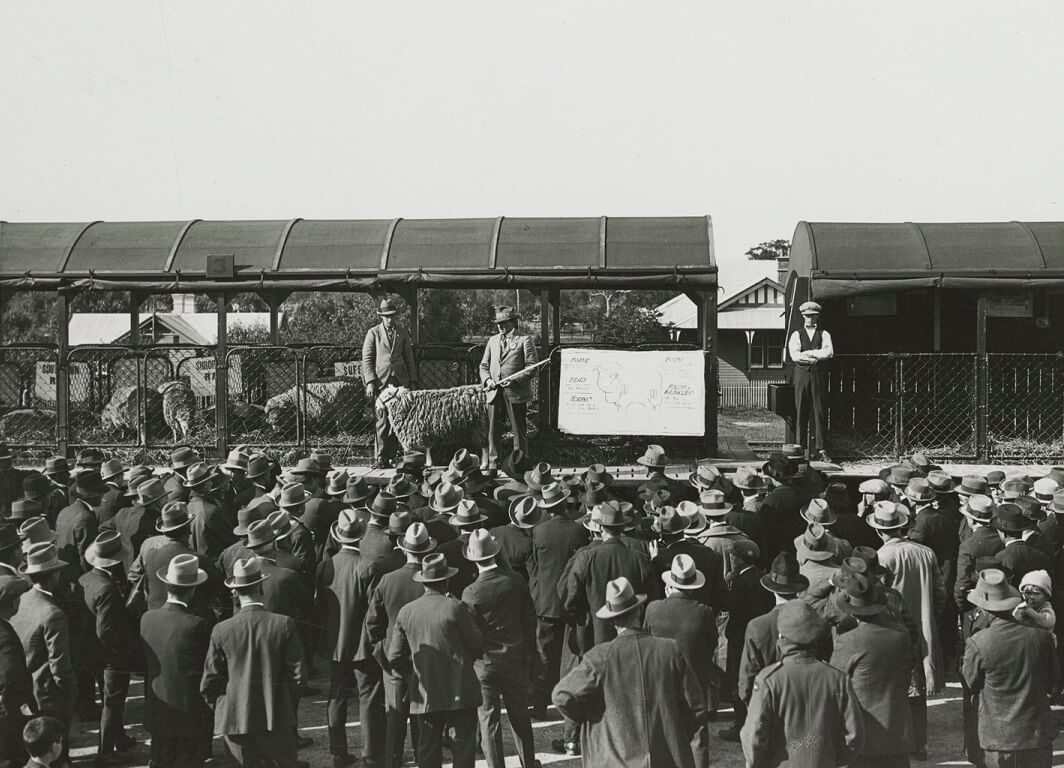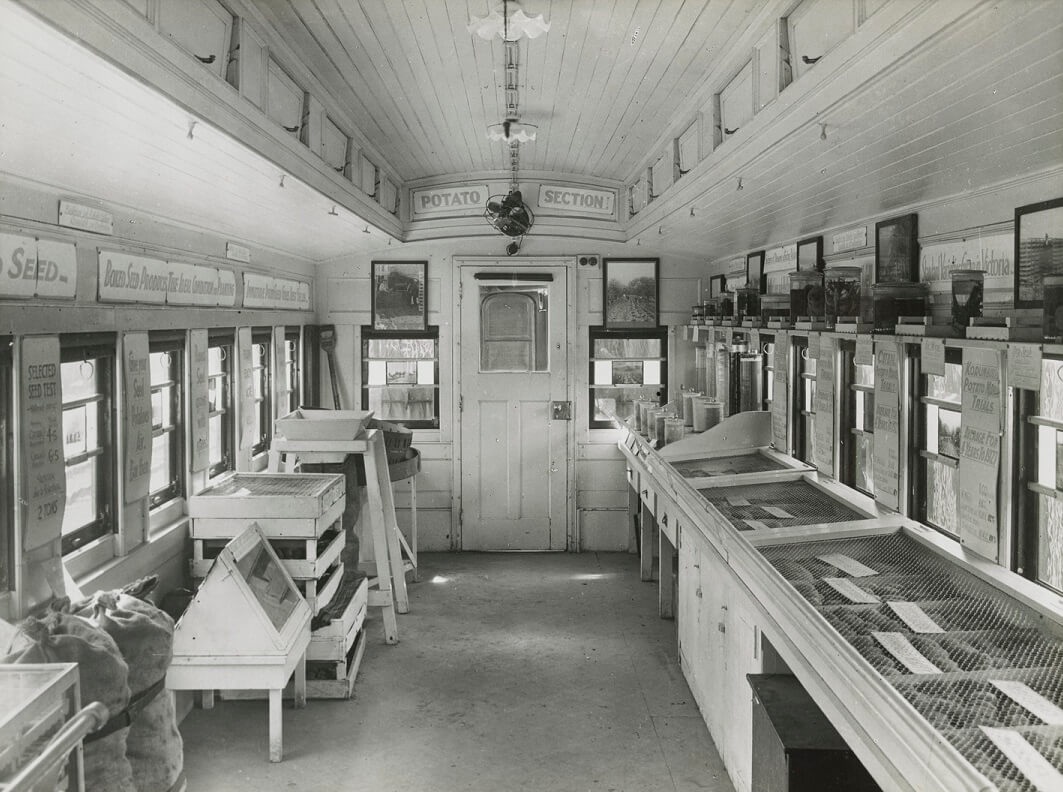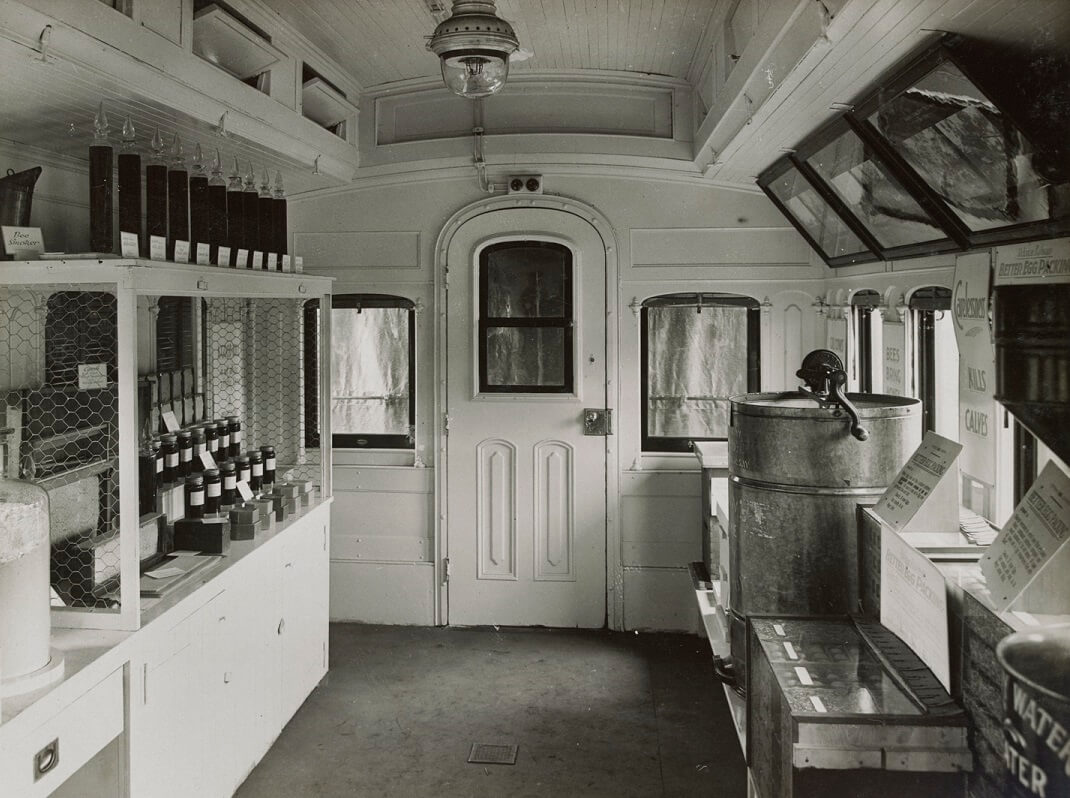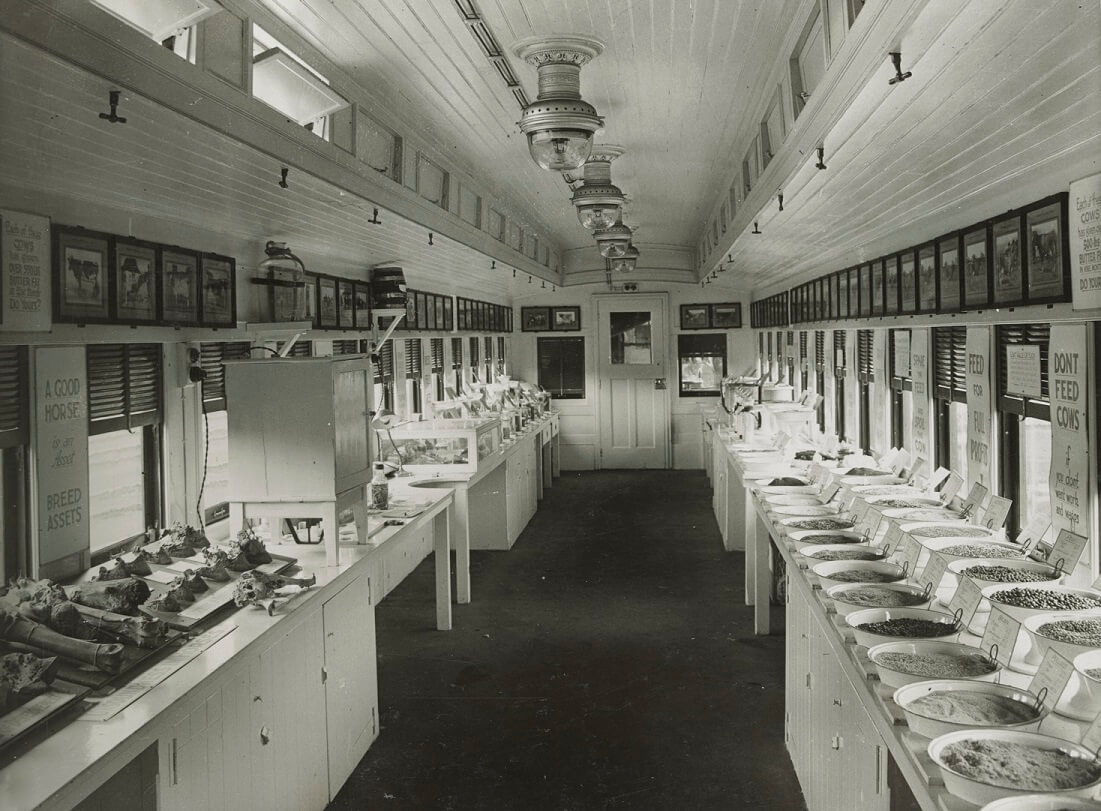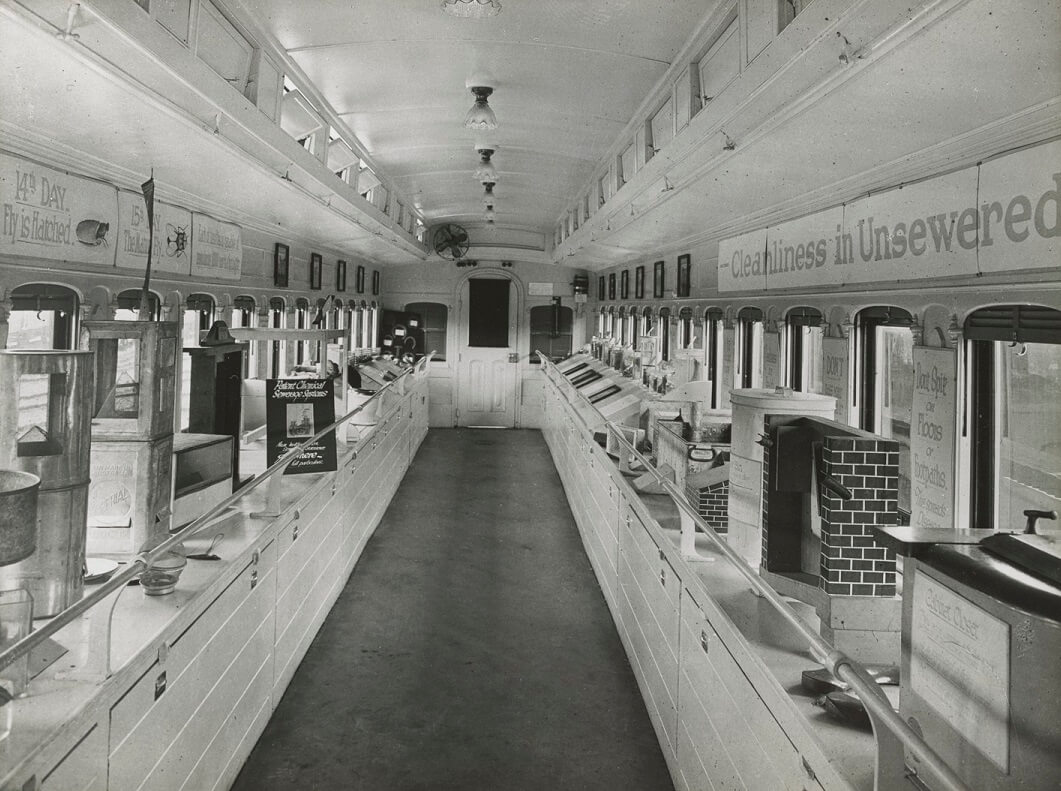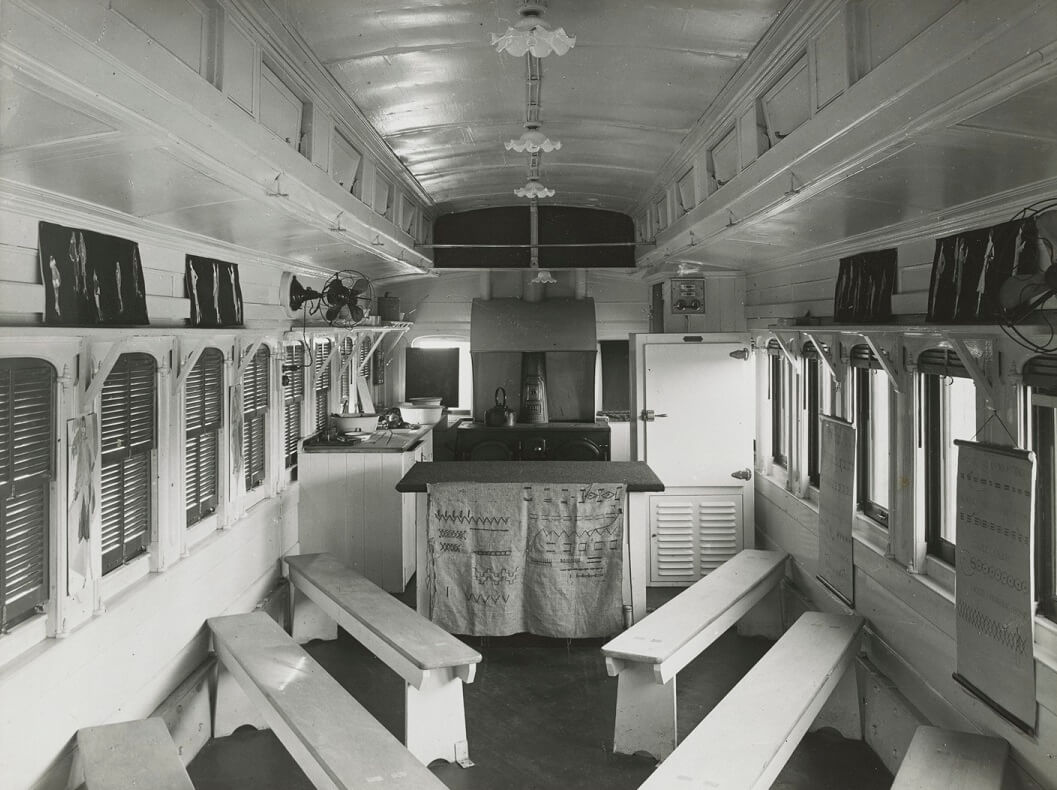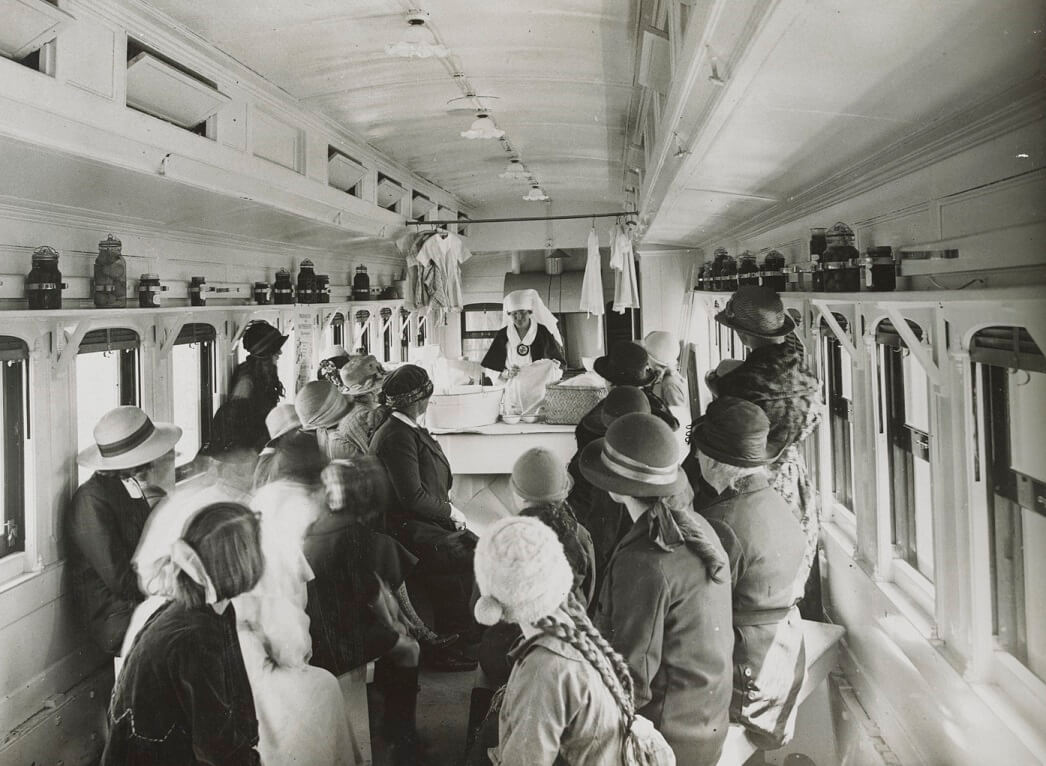Victorian railway men who have visited Europe and America say that the Better Farming Train is the most complete and efficient of its kind ever put on the rails.
The train — 225 yards of canary-colored vehicles — left Flinders Street this morning for Gippsland. It was the strangest caravan that has ever left Melbourne. Its personnel included experts in every department of agriculture, and several exponents of domestic arts.
The vehicles carried prize livestock, models of farm buildings and plant, food samples, novel feeding utensils, exhibits of top-dressed pastures, and a lecture room with picture-projecting equipment.
The Herald, 13 October 1924
MR BRUCE’S PRAISE
Mr Bruce, Prime Minister, said: “This train has supplied what has been wanting in Australia — a practical demonstration of how to bring science to bear in farming and to enable the farmer to get the fullest possible use of his land. The importance of the work that this train will do cannot be too strongly stressed…
It gives farmers, particularly small farmers, a wonderful chance of education in the application of the most modern scientific methods to their industry. Similar efforts of the sort have been made in America and Africa, but none of them nearly so complete as this one, made by the Railways Department and the Department of Agriculture.
I have taken the opportunity of inspecting the train at its first stopping place. I cannot speak too highly of the manner in which the train has been made up nor of the immense value of the work it will do.’
The Herald, 14 October 1924
The value of this ‘agricultural college on wheels’ is now generally recognised throughout the length and breadth of Victoria. The improved results of the wheat grower, the dairy farmer, the pig raiser, the orchardist, the poultry keeper, and the sheep breeder have all shown the practical advantage of the modern methods as compared with the unsystematic, obsolete, or unscientific methods that previously were common in many areas. I can say that the results have exceeded expectations.
Commissioner Harold Clapp, in the Numurkah Leader, 26 January 1932
The ‘Better Farming Train’ was launched in Australia in 1924. Its purpose was clear: to educate farmers to ‘employ better methods in all branches of agriculture, to encourage the keeping of better stock, to improve conditions in the homes of the men on the land, and generally to raise the standard of every phase of rural life.’
The train toured rural Victoria throughout the interwar period. Exhibits on board encouraged farmers to adopt new, scientifically-tested, farming methods, whether the latest pasture cultivars or fertiliser application. One carriage, for example, carried grass specimens illustrating the ‘before’ and ‘after’ effects of top-dressing pastures with ‘artificial manures’. Another carriage was devoted to lessons in dairy management. The value of herd testing as a means of increasing herd production was emphasised, as was ‘the importance of feeding on a generous scale.’
The Better Farming Train was the brainchild of the dynamic Harold Clapp, Chairman of the Victorian Railways Commissioners, and was run in collaboration with the Department of Agriculture. Clapp acknowledged the railway’s ‘activities to stimulate primary production’ were not ‘entirely disinterested.’ Any help given to the ‘man on the land’, he explained, ‘is likely to be reflected in increased traffic, both goods and passenger, for the railways to carry.’ The train was an overwhelming success. Dr Samuel Cameron, the Victorian Director of Agriculture, wrote in 1925: ‘I have no hesitation whatever in saying that the Better Farming Train… has made a greater appeal to the practical farmer and the younger generation of agriculturalists than anything that has hitherto been attained in Australia.’ Visiting Reverend, Dr Lauchlan Maclean Watt, declared in 1932 that the train was ‘a stroke of genius’ — ‘The train is one of the greatest things in the world — an apostle of prosperity and enlightenment.’
The Carriages
Painted bright canary yellow, the train was hard to miss. Up to 15 carriages were towed, made up as follows:
Victoria car — Sleeping accommodation for staff on board, dining room, kitchen and shower. The train transported 80 staff, including livestock handlers and experts across a range of areas to provide the lectures and demonstrations and teach classes to adults and youth.
Louvre trucks — Fodder for stock.
Cattle trucks — Bulls, cows, and heifers, as exhibits.
"Q" fiat truck — Fitted for pigs.
"Q" flat truck — Lecture platform, models of stock feeding utensils and veterinary exhibits.
AB car — Dairy utensils and herd testing exhibits, honey and hives.
AB car — Food samples and feeding, milk and its products, bacteriology of milk.
AB car — Tobacco and potatoes.
AB car — Exhibits of top-dressing of pastures, green fodders, grasses and clovers, noxious weeds.
"Q" flat truck — Fitted with boxes 12in. deep containing actual sods of growing grasses cut from the field. These grasses were taken from plots in different parts of the state. Some had been top-dressed with artificial fertilisers, and others for the purpose of contrast had not.
AB car — Lecture car, fitted to seat approximately 80 persons.
AB car — Fitted up for the purpose of ‘completely demonstrating all in the way of domestic practice that is to the advantage of the housewife.’
When the train arrived at a station, the carriages were opened to the public. The livestock on board the train was walked out into yards, and the pasture plots were assembled. The displays were accompanied by a series of lectures and demonstrations, with information on new agricultural initiatives and techniques.
Instructions were clear and explicit — ‘Wage war on weeds’, ‘Feed your fields and flourish’, “Use phosphates and enlarge your bank account”; and “Keep the plough going.” As historians, Holmes and Mirmohamadi point out, the train offered both reassurance and warning:
“Healthy crops make wealthy owners”; “Feed your land and it will feed you”; and “Diminishing yields denote bad farming.” … farming was a predictable enterprise where simple rules could be followed and success assured: fallow your fields, use fertilizers, work hard, eradicate weeds, think about what you are doing, and success should follow. Success was about the right approach, the right attitude, and the right additives. The variables of climate, soil quality, and size of holdings did not feature in this inventory of qualities that would ensure fortune. The Better Farming Train, instead, emphasized the individual farmer, whose physical, intellectual, and moral fibre would carry him and his family through the challenges of farming life.
The Audience
‘Soldier Settlers’, new to the land, were particularly appreciative of the advice offered by the Better Farming Train. After World War I returned servicemen could purchase blocks of farming land under a nationwide war repatriation program. The government required no deposit for the land, and exempted payments for three years. Soldier Settlements were established in the dryland farming areas of the Mallee, South Gippsland and the Western District, and in the irrigation areas of the north-west along the Murray, central Gippsland near Maffra and Sale, and the Goulburn Valley. In Victoria almost 12,000 soldiers took advantage of the ‘Soldier Settlement Scheme’, but only 20 per cent had any farming experience. Some had never set foot on a farm:
What the… farmers have suffered from most has been a want of knowledge — not the sort of knowledge acquired at school, but that having intimate relation to the treatment of their land and their livestock, the influence of manures on the growth of crops, and the means of utilising their resources in the most economical manner.
The Better Farming Train provided farmers with useful knowledge and support. And it was gratefully received. The Sunraysia Daily reported in 1926:
Mr J C Barrow is one of the soldier settlers at Karadox. Conversing yesterday about the Better Farming Train and its value to the man on the land, he said: “I have gained much valuable general information, but particularly valuable information regarding… fallowing, diseases of wheat, etc. There was not, however, one lecture that would fail to teach a farmer something he ought to know.
The ‘Women’s Section’
There were specific carriages on the Better Farming Train dedicated to women and girls. These offered information and classes on needlecraft, cookery, and infant health and welfare. Three women were included on the Train’s first trip — Flora Pell, cookery demonstrator, Sister Peck from the Victorian Baby Health Centre and Mrs Stoner, the government supervisor for dressmaking and needle work in State schools. Sister Peck led the women’s cars and travelled with the train on many of its subsequent trips.
Women were told that housework and homecraft were not ‘mere drudgery, but can be, and should be, a most fascinating field of activity’. Leaflets on the safeguarding of milk, ‘infantile complaints’ and other subjects were distributed. A model cot, made to a design patented and invented by Sister Peck, was ‘particularly admired by the visiting mothers’. The cot resembled a large meat safe fitted with a mattress and was ‘absolutely flyproof, hygienic, and secure’. The importance of method in cooking and the correct weighing were discussed. A healthy diet was emphasised, with recipes for curry casseroles, celery cream soup, gem scones and sausage rolls. The importance of ‘making do’ was imparted. Exhibits of simple milk coolers made of kerosene tins were on display, as were samples of slippers made of old felt hats and ‘articles of interest made from sugar bags’.
From its inception the train focussed on ‘mothercraft’, the West Gippsland Gazette reporting:
Sister Peck, who is an accomplished nurse, gave a series of useful talks on the simple, but all important natural subjects of bathing and feeding a baby. To the superficial thinker such lessons would seem to be needless. Does not the ordinary girl or woman know all these things by intuition? Does not Nature teach them? Well, Nature does wonders in many directions but for the girl who has had to earn her living in a shop, with no adequate opportunity for acquiring domestic experience, Nature does very little in supplying the deficiency. Away from her home, earning her livelihood, what opportunity has she for teaching herself the manifold duties which go to make a practical wife and mother? Yet, unless she is equipped with such knowledge, marriage is very likely to end in failure.
It is just here that the lessons given by Sister Peck, of the Baby Health Centre, are seen to be of even national importance, for the babies of to-day are the progenitors of the future generation. A baby properly fed and nourished, grows up to be a national asset, while another, fed on improper diet through ignorance, on the part of a young mother, is liable to be handicapped in the race of life. Not only in the feeding, but in clothing, the making of suitable clothes, and the general care of the baby, valuable information was imparted, which is calculated to have an important effect, in the aggregate, on the infant mortality of the State.
With a life-sized celluloid doll, practical demonstrations in the bathing and handling of an infant were given by Sister Peck, and if any unexperienced man thinks it is a very simple matter to handle a slippery, tiny baby in its bath, let him try it at once on someone’s baby, first insuring the child for £5000 in the name of the mother. Because of the value of the information imparted, especially to young women, this department of the train should be welcomed everywhere, as indeed it is.
Practical femininity was emphasised and women were encouraged to think of themselves as ‘nation-builders’.
Sister Peck became the primary spokesperson for the women’s carriages on the Train. She was quoted in 1929: “I try to explain to the school girls… how we study to take better care of animals, and how reasonable it is that we should also study the better bringing up of our country babies.’ Just as piglets would die in her inexpert care, she said, ‘the same result would occur probably if any of her youthful audience, accustomed to the care of valuable farm animals, were given the charge of a young baby, the ‘finest and most valuable animal in the world.’’
The ‘Women’s Section’ proved incredibly popular. Women came in their droves, sometimes travelling long distances ‘at great personal inconvenience’ to attend the lectures. The carriages were frequently packed out. The Argus reported in 1924 that the ‘domestic science car’ was ‘not nearly large enough to accommodate all the women present.’ At Mildura in 1926 the child welfare car was ‘packed five times in succession’. Argus Journalist, Stella Allen, advertised the Train in her popular section, the ‘Women’s Realm’, reflecting the wide appeal of the train to women:
Sister Muriel Peck (nurse assistant to the director of child welfare and lecturer on the train on maternal and child welfare) has added to her exhibits for demonstration purposes a number of new English posters published by the Dental Board of England, and others, depicting the evils of the fly nest, as well as a special cabinet for demonstrating a balanced diet for prospective and nursing mothers. On the cabinet shelves are baskets containing specimens of the right food, including milk, eggs, brown bread, and a variety of fruit and vegetables. The correct proportions are set out on cards with the exhibits, with the statement that meat should be taken in accordance with medical advice. As the exhibit will remain stationary during the tour, Sister Peck has boiled her eggs hard, her tomatoes are made of solid paraffin, and coloured, and her cabbages and lettuces have been specially made for her. The root vegetables are fresh, but others, as well as the fruit, are excellent imitations.
Public health was high on the agenda, with a focus on hygiene in rural areas. Magic lantern slides and films covered topics such as ‘The Spread of Disease’ and ‘The Danger of Flies’. Visitors were shown practical first aid, such as the immediate treatment of snake-bite and other bites or stings, and how to treat sunstroke. Pamphlets dealing with the more common health subjects were distributed free — those on disease including diphtheria, whooping cough, measles, scarlet fever, dengue, infantile paralysis, consumption, typhoid fever and venereal disease. ‘One of the most interesting exhibits’, it was reported, was ‘an open air chalet for treating consumptive patients.’
Leaflets outlining methods of controlling flies, mosquitoes and cockroaches were handed out. One exhibit included a model of a modern fly-proof window designed to exclude pests from the house. ‘Devices for improving the sanitation both of country dwellings and townships’ were also on display. There were examples of septic tanks, chemical closets and pan closets. There was a model of a simple type of garbage incinerator, and one of a rain water interceptor designed to exclude dirt, leaves and other debris from being washed into drinking water tanks from surfaces and gutters. A district health officer accompanied the train and could be consulted ‘with regard to rural sanitation, the prevention of disease and the promotion of Health.’
Between 1924 and 1935 the Better Farming Train made 38 tours throughout regional Victoria and was visited by about 250,000 people. Tours were cut back during the economic downturn of the 1930s, and reluctantly disbanded in 1935.
‘Better Farming Train at Bunyip’, Weekly Times, 25 October 1924
Reproduced courtesy National Library of Australia
The train’s first stop was at Bunyip, in Gippsland, Victoria. The Herald reported:
If the reception accorded to the Better Farming Train at Bunyip yesterday be a criterion, the train will be a great success, and will do important work in improving agriculture.
Many of the farmers who came to scoff remained to learn. Ideas that would have fallen on deaf ears in ordinary circumstances, were made acceptable by demonstration. The Better Farming Train is an experiment in Victoria. Its career should be a long and useful one.
Among those who met the train at Bunyip was the Prime Minister, Mr. Bruce, who, after inspecting the exhibits, expressed the ‘utmost pleasure’ at what he had seen.
“BETTER FARMING” TRAIN
— Victoria Again Sets the Pace —
Our readers are familiar with some of the work being done by the Victorian Railway Department to help the man on the land, and especially the fruitgrower. Its latest move, run in conjunction with the Agricultural Department, has been the despatch of a “farmers’ train” on a ten days tour through the Gippsland districts. The tour cost £5000 but in the opinion of Mr. Clapp and Dr. Richardson (Superintendent of Agriculture) it was worth every penny of the money. The train carried a staff of departmental experts, typical livestock and everything necessary to illustrate the lectures and demonstrations given at the railway stations, where farmers, their wives and families had gathered for the occasion. These addresses and demonstrations were not confined to such subjects as agriculture, dairying, pigs, potato and tobacco, but embraced cooking and baby welfare and other matters of interest and help to the farmers’ wives.
Altogether there were 15 vehicles, having a total length of 670 feet, and they are painted yellow or canary colour. Along each side, in large black letters, are the words “Better Farming Train’. The idea in using such a strong colour was to ensure it attracting attention, and the plan has succeeded admirably. Never was a more imposing or remarkable train seen anywhere in the Commonwealth, and never before did a train carry such inspiriting and helpful messages to the people.
One coach is filled with boxes of pasture land, lifted bodily from paddocks in widely separated portions of the State. Their purpose is to illustrate the benefits to be derived by the regular distribution of superphosphate on grass lands. These may be fairly described as one of the most noteworthy features of the train.
Another van is devoted to lessons in dairy management, and associated with this are cars in which high-class, typical specimens of the various breeds of dairy cattle are accommodated.
In one of the vans in charge of officers of the veterinary staff are numerous exhibits, which have been so arranged and labelled as to enable visitors to discern at a glance the condition presented by different organs and portions of cattle and other animals when affected by the diseases which attack them. This is a vehicle which every man interested in live stock finds it extremely difficult to leave.
All of the others, however, deserve attention. All sorts of fodder plants in the green and the cured state have been arranged in one of them and there is also a comprehensive collection of noxious weeds. Another car contains different varieties of potatoes, samples of properly sprouted and badly sprouted seed tubers, tobacco leaf and so on.
The womenfolk are specially catered for in a vehicle devoted to problems of domestic economy and health matters, and which, it is instructive to note, is fitted with fly-wire screens and doors and windows. Flies are a menace to health whether in the country or in the city, and every reasonable provision should be made to exclude them from the homes, and to destroy any that gain entrance thereto.
On one truck has been mounted a miniature poultry farm, which is calculated to teach many valuable lessons in the feeding of pullets and hens with a view to ensure maximum egg production.
Liberally distributed throughout the cars are cards setting forth facts of interest and importance. For the most part they are much to the point, and the truths which they tell in bright, crisp sentences cannot fail to bear rich fruits.
At night the whole of the train is electrically lighted, and while some of the visitors are guided through the different cars and informed of the purpose of the exhibits, others are filled to overflowing with facts and figures having an essential practical bearing upon the work in which they are engaged.
Bunyip, 19 December 1924
‘See the Better Farming Train’, by Percy Trompf, artist, c.1924-1939
Reproduced courtesy State Library Victoria
SPIRIT OF INQUIRY
Throughout the country there is abroad today a spirit of inquiry. The wheat-growers, the dairymen, the horticulturists, the irrigationists all are seeking enlightenment. No longer
are they content to work by rule of thumb. They want to know not only how to do things, but the purpose underlying them, and the possible means of increasing both the effectiveness of the operations, and the returns therefrom.
The Better Farming Train could not have been equipped and launched on its great campaign at a more auspicious time. The primary producers, wherever it has gone, have welcomed it with open arms. They have come from far and near to examine the admirably instructive exhibits arranged within it, and they have listened with eager attention to the addresses given by the accompanying officials.
It looks now as though the train is to become a permanent institution. That is something to be proud of, and pleased about. It is a complete answer to those who predicted that the train would be short-lived, because of its failure to appeal. It is a fine tribute to the skill of the departmental lecturers and demonstrators and the confidence which the public have in them, and it proves in a convincing manner the progressive mental outlook of the present-day men on the land.
Weekly Times, 27 November 1926
Families inspecting the Better Farming Train, Underbool, Victoria, 1927
Reproduced courtesy Museums Victoria
Farming families during a visit of the Better Farming Train, Underbool, Victoria, 1926
Reproduced courtesy Museums Victoria
Better farming train in Yinnar, by Martin Walker, photographer, c.1930
Reproduced courtesy State Library Victoria
The Better Farming Train was lauded by an enthusiastic public and supportive press. Some families travelled more up to 80 miles (120 kms) to see the train, and lecture cars proved too small:
… deep interest had been taken in the train everywhere. It had aroused a response from the public which far exceeded the most sanguine expectations of those who had planned it. The lecture car intended to accommodate about 100 people had proved much too small, and overflow gatherings had had to be held.
Families came for a ‘day out’, and there was something of a ‘country fair atmosphere’ when the train arrived in town. The farmers themselves were active participants, grateful for the advice the experts imparted. Historians, Katie Holmes and Kylie Mirmohamadi elaborate:
Their support for the endeavor was, according to the Argus, “whole-hearted and sincere.” The Sunraysia Daily in August 1928 also highlighted the approval of locals, noting that “[a] very fine and experienced Mallee farmer” spoke of visiting the Better Farming Train three times. A pamphlet distributed during the 1928 tour acknowledged the range of farming experience and expertise in the region by suggesting “wheat growers, no matter how experienced they may be, will find much to interest them on the train, and this opportunity of increasing their knowledge and placing their problems before the officers of the Department of Agriculture should not be missed.” In 1929, the Argus reported that a farmer from Beulah who had attended the Train’s demonstrations in 1926 and had followed the advice to change his wheat variety, had increased his wheat yield from five to nine bags an acre. Such reports suggest that some farmers at least thought the knowledge advocated by the Train’s experts superior to their own.
The train promoted ‘the beneficial effects of superphosphates’. Living displays demonstrated the usefulness of chemical fertilisation, and labels and lectures encouraged its use.
Exhibitions also featured new strains of drought-resistant wheat and explanations of common wheat diseases and how they occurred — science was the panacea for all.
‘Fallowing, Pickling and Rotation of Crops’, Better Farming Train, by Victorian Railways, photographer. C.1925
Reproduced courtesy State Library Victoria
Not all ‘science’ advocated by the Better Farming Train had long-term benefit. A system of dry-land fallowing was one of the key techniques encouraged by experts on the train. Fallowing involved disc-plowing the soil after rain, thus trapping the moisture below the surface and reducing evaporation.
The system of fallowing was widely adopted across the Victorian Mallee, with disastrous results. We now know excessive tillage destroys the soil structure, depletes soil fertility, and causes erosion. Historians, Katie Holmes and Kylie Mirmohamadi, explain:
The Better Farming Train efficiently promoted the agricultural orthodoxy of scientific farming methods, which were ultimately recognized as unsuited to the environmental conditions of the Mallee. The initial step of clearing the area of mallee scrub, and the fallowing that followed caused lasting environmental damage in the Mallee. Deprived of the stubborn clinging qualities of the mallee roots, which bound the fine ancient soil together, thousands upon thousands of tons of topsoil found its way to distant lands.
But advice from experts on the Train reflected the current state of scientific knowledge. Inadequate as it proved to be in the Mallee, it was dispensed in good faith.
‘Herd Testing, Stock Foods ad Dairy Hygiene’, Better Farming Train, by Victorian Railways, photographer. C.1925
Reproduced courtesy State Library Victoria
‘Dairy Utensils’, Better Farming Train, by Victorian Railways, photographer. C.1925
Reproduced courtesy State Library Victoria
‘A Lecture on the “Friesians”, Better Farming Train, by Victorian Railways, photographer. C.1925
Reproduced courtesy State Library Victoria
The dairy car was reportedly ‘well arranged’. Dairy breeds — Ayrshires, Jersey, Friesian, Red Poll and Short-horn — were on display. Lectures were given by officers of the Dairy Division of the Department of Agriculture on breeding and feeding of dairy cows.
The care and sterilisation of dairy utensils was particularly stressed, as was the conservation of fodder — Models of silos and pits for this purpose were shown. One exhibit showing the production of by-products from ten gallons of milk was, according to reports, ‘most instructive’.
The list of what can be produced is as follows: - 33 lbs. condensed milk; 10 lbs. cheese; 5 lbs. milk sugar; ¾ lb. Albumin; ¾ lb milk ash; 4lbs butter; 3 lbs casein; 13 lbs. full milk powder. Each of the above is an alternate to the other.
‘The Pig Truck’, Better Farming Train, by Victorian Railways, photographer. C.1925
Reproduced courtesy State Library Victoria
Lecture on the breeding and care of pigs, Better Farming Train, by Victorian Railways, photographer. C.1925
Reproduced courtesy State Library Victoria
The pig truck comprised ‘some fine specimens’ of boars and sows of the Large and Middle Yorkshire breed, as well as Berkshires. The various methods of caring for pigs were demonstrated. Models of styes and pig runs were on display, as were sides of bacon showing good and inferior types. Correct methods of feeding were advocated for the production of good bacon — ‘5 pounds of grain fed to a pig will produce 1 lb of pork, and a bushel of wheat will produce 12 lbs. pork.’
As with most exhibits on the Train, this section provided plenty of illustrations of the ‘good and bad ways’ of doing things:
An exhibit of pork is carried. Two sides have been taken from pigs, the same age, fed exactly the same way, and reared under exactly similar conditions. Yet one side is valued at sixteen pence a pound, and the other at elevenpence. One is a pure bred, and the other a mongrel.
The fivepence a pound difference can be procured by the farmer without any real extra cost. It is just the difference between good and class breeding.
‘The Wool Car’, by Victorian Railways, photographer. C.1925
Reproduced courtesy State Library Victoria
Lecture on the breeding of sheep, by Victorian Railways, photographer. C.1925
Reproduced courtesy State Library Victoria
A large variety of rams and ewes travelled with the train — Polwarth, Border Leicester, Ryland, Suffolk, Lincoln, Southdown, Merino, Corriedale, English Leicester, and Dorset Horn. Samples of wool were on display. The selection of first-class sires for the flock was stressed, both for the production of fat lambs for market and for the improvement of the fleece. The ‘fly pest’ was dealt with, and simple yet effective traps were shown, as attachments for the ordinary petrol or kero tin.
‘The Potato Section’, by Victorian Railways, photographer. C.1925
Reproduced courtesy State Library Victoria
Potato culture was also dealt with in detail, and tubers were shown in bottles, showing the various diseases and giving a remedy for each. Samples were shown of 22 commercial varieties grown of Victoria.
‘Honey and Eggs’, by Victorian Railways, photographer. C.1925
Reproduced courtesy State Library Victoria
Bee hives and apparatus for apiary work and the extraction of honey were on view. The Argus reported in 1929:
Samples of honey from the different plants and trees were shown and the big contrast in colouring of the honey was very noticeable.
‘Diseases of stock and values of stock foods’, by Victorian Railways, photographer. C.1925
Reproduced courtesy State Library Victoria
The veterinary section had a number of ‘attractions’ and was particularly popular with visitors. Jars containing the diseased organs of animals were on display and the combating of the various diseases was explained. Sections of horses’ feet and bones were shown — no doubt delighting children — and the making of a temporary yard for the marking of lambs was advocated as using old yards could spread Tetanus or cause blood poisoning.
‘Public Health Car’, by Victorian Railways, photographer. C.1925
Reproduced courtesy State Library Victoria
The Health section had some ‘drastic but nevertheless necessary information to impart’.
Flies and their destruction received a good deal of attention, and screens and traps were demonstrated. The detection of inferior tinned foods was explained, ‘it being pointed out that any tinned food that had the sides or ends of the tin puffed out, was not in a fit state for eating.’ Common diseases, water purification, ventilation, and the destruction of mosquitoes were dealt with.
‘Cookery and Needlework Demonstration Car’, by Victorian Railways, photographer. C.1925
Reproduced courtesy State Library Victoria
A lecture on ‘child welfare’, Better Farming Train, by Victorian Railways, photographer. C.1925
Reproduced courtesy State Library Victoria
An encouraging account is given of the response of the women in Victoria to the visit of the better-farming train. Sister Peck, in her report, says that each trip seems to be more successful than the last, no doubt because the train and its usefulness is becoming more widely known.
The women’s section was crowded at every centre. Lectures and demonstrations in cookery, needlecraft, and mothercraft were given continuously each day, and even in some quite small townships the crowds were so great that overflow demonstrations had to be given on the platform so that women would not be disappointed. At some of the larger towns a number of people simply could not get near owing to the crowds.
At Mildura the child welfare car was packed five times in succession. In many centres special lectures were given to school children and at Murrayville a number of people attended who had come from South Australia. They said they did not mind the distance they had to travel, as what they learned was well worth the trouble.
Over 200 mothers came for information and help in the care of their infants. Medical men who inspected the car expressed their thanks for the lectures given, and said that the mothers were learning that they could have healthier babies by applying scientific methods to the feeding and general care of them. During the tour 12 districts were visited and 2,310 women attended the child welfare lectures alone.
The Register, 14 September 1926
Author: Ann Wilcox
Next Topic- On the Street
Further Reading
Online sources:
Flora Pell: Australia’s first domestic goddess
Secondary sources:
Jessie Suzanne Matheson, Countryminded Conforming Femininity: A Cultural History of Rural Womanhood in Australia, 1920-1997, Ph.D. thesis, School of Historical and Philosophical Studies, The University of Melbourne, 2021
Kate Darian-Smith, ‘Domestic Spaces and School Places: vocational education and gender in modern Australia’, in Designing Schools: Space, Place and Pedagogy, Abingdon, Oxon; New York, NY, Routledge, and imprint of the Taylor & Frances Group, 2017
Katie Holmes and Kylie Mirmohamadi, ‘All Aboard for Modernity: The Better Farming Train’, Agricultural History, Vol. 91, No. 2, Spring 2017, pp. 215-238
Ken Frost, Soldier settlement after World War One in south western Victoria, Ph.D. thesis, School of Social and International Studies, Deakin University, 2002
Jessie Suzanne Matheson, Countryminded Conforming Femininity: A Cultural History of Rural Womanhood in Australia, 1920-1997, Ph.D. thesis, School of Historical and Philosophical Studies, The University of Melbourne, 2021
Robert Crawford, Judith Smart and Kim Humphery, editors, Consumer Australia: Historical Perspectives, Newcastle, Cambridge Scholars, 2010

